
25 |
Text by Carin van Ginkel |
|---|---|
Flowering plants are the most diverse group of land plants, comprising >250,000 species found in almost every habitat. They can be conveniently divided into two groups, based on number of cotyledons – the monocotyledon and dicotyledon plants – although the latest classification system in fact accommodates more plant groups.
Parallel-veined plants
Monocotyledons
Monocotyledon leaves are parallel-veined and typically have flower parts in threes or multiples of three.
Water-plantains
Family Alismataceae
Herbaceous aquatic plants with linear to arrow-shaped leaves and long distinct leaf stems (petioles). Flowers have three sepals that often persist in fruit. Flower petals white, pink or purple, sometimes with yellow or purple spots. Stamens 3, 6, 9 or many. Freshwater representatives comprise 17 genera with 111 accepted species.
1 Water alisma
Alisma plantago-aquatica

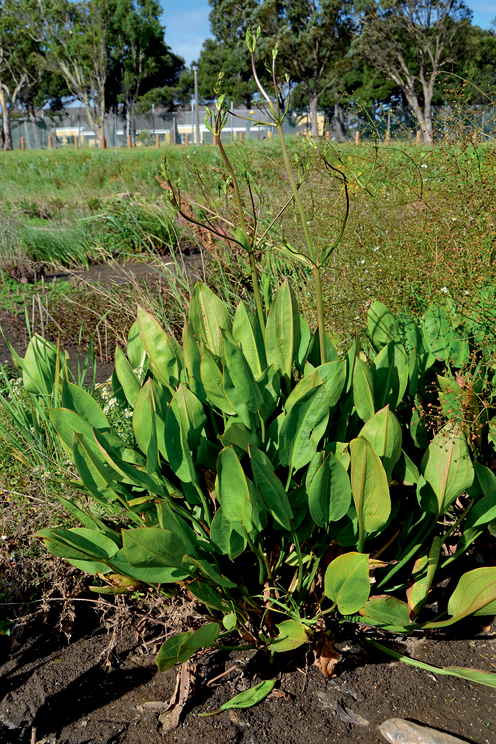
© C. GRIFFITHS
Rooted, submerged or emergent, naturalised exotic aquatic herb. Stems are underground rhizomes. Leaves simple, erect, with several veins arising from base. Flowers small, from white to pink. Seeds float during dispersal. Size: Typically 0.3–1m in height. Biology: Found on margins of streams and pools at altitudes of 0–1,560m. Plants flower October–March. The plants are traditionally used to treat rabies and mammary congestion.
2 Broadleafed arrowhead
Saggitaria latifolia

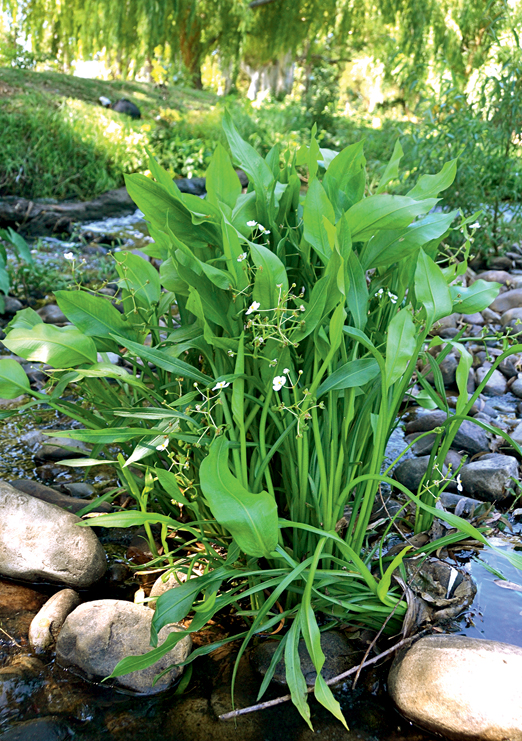
© C. GRIFFITHS
Perennial herb with creeping roots that produce white tubers. Leaves with long stems and broad arrow-shaped blades. White flowers borne on a long stem and arranged in threes, male flowers with prominent yellow stamens. Size: About 50cm in height. Biology: Introduced species, native to North America, but widely naturalised in Europe, Australia, South Africa and elsewhere. Grows along banks of streams or in shallow water. Flowers in spring and summer. Tubers can be eaten raw or cooked, much like potatoes, and have long been used as a food by indigenous people in the Americas.
Lilies
Family Amaryllidaceae
Bulbous herbaceous plants with basal leaves. Leaves appear at different times than the flowers. Inflorescence an umbrella-like cluster. Flower perianth in two whorls with six segments. Seldom more than six stamens. Plants found in the warmer parts of the world and comprise 75 genera with 1,600 species.
3 Marsh lily
Crinum campanulatum


© J. WENTZEL
Large to small, broad-leaved, emergent, clump-forming, aquatic endemic plant. Stems bulbous with chanelled, linear, green leaves. Flowers pink and trumpet- or bell-shaped. Fruit with irregularly shaped fleshy seeds. Size: Typically 0.2–0.6m in height. Biology: Found in temporary pools and seasonal marshes in Eastern Cape grasslands, at altitudes of 250–800m. Flowers spring to summer. A good pond plant, needing shallow water and a winter drying-out period.
4 Vlei lily
Crinum paludosum


© J. ENGELBRECHT
Broad-leaved, emergent, clump-forming, aquatic native bulb. Stems bulbous with soft, arching, linear pale green leaves. Flowers slightly scented, white to pale pink, with darker keel and red stigmas. Fruit capsules have fleshy seeds. Size: Typically 0.2–0.5m in height. Biology: Found in seasonal pans and marshy areas in the northern parts of South Africa and further northwards in Africa, at altitudes of 150–1,650m. Plants flower December–February.
5 Fire lily
Cyrtanthus angustifolius


© J. VLOK
Broad-leaved, emergent, clump-forming, aquatic indigenous plant. Stems bulbous, with linear green leaves. Flowers tubular, scarlet and nodding. Size: Typically 0.2–0.5m in height. Biology: Found in seasonal pans and marshy areas at altitudes of 150–650m. Plants flower October–February. An attractive plant for marshy and sunny parts of the garden.
1 George lily
Cyrtanthus elatus


© J. WENTZEL
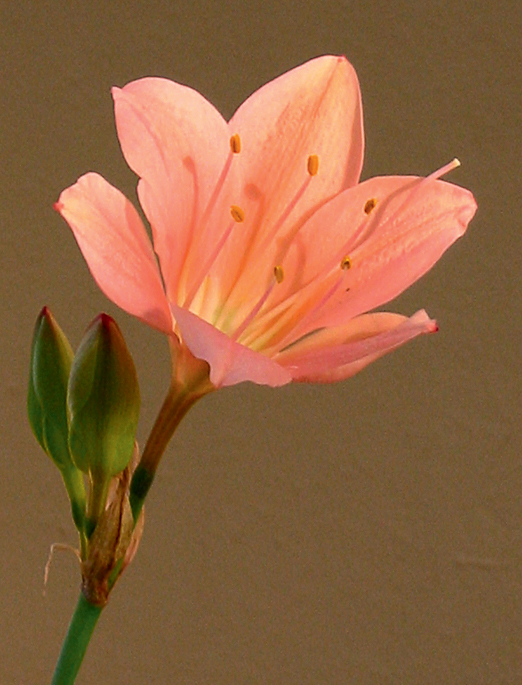
© J. WENTZEL
Endemic bulb. Stems light green; leaves broad, with several present when flowering. Flowers large, scarlet or, rarely, pink (1a), widely funnel-shaped, sub-erect in terminal cluster. Size: Typically 0.2–0.45m in height. Biology: Found on wet forest margins and moist mountain slopes in the Western and Eastern Cape, at altitudes of 600–1,200m. Flowers June–October. A popular garden plant, cultivated worldwide as a cut flower.
2 Ifafa lily
Cyrtanthus mackenii


© J. WENTZEL
Endemic bulb. Stems bulbous with linear grey-green leaves. Flowers scented, tubular, yellow or cream and in a drooping terminal cluster. Size: Typically 0.2–0.3m in height. Biology: Found on stream banks in the Eastern Cape, at altitudes of 15–600m. Flowers June–October. The population of plants is declining, owing to habitat degradation caused by agriculture.
Waterblommetjies and Cape pond weeds
Family Aponogetonaceae
Perennial plants with or without floating leaves. Leaves oblong to lanceolate, with a long distinct leaf stem. Flowers borne on a solitary or forked spike. The flower perianth (including the petals and the sepals) has 1–3 white or coloured segments. Has six or more stamens. Freshwater plants found in Africa, Asia and Australia and comprising one genus with 40–50 species.
3 Water onion
Aponogeton angustifolius


© C. VAN GINKEL
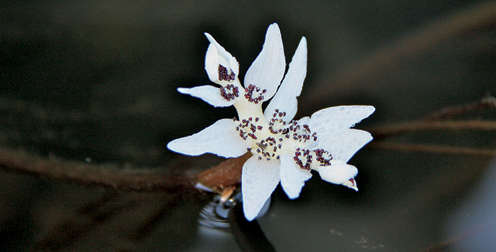
© C. VAN GINKEL
Rooted endemic with spongy stems. Submerged leaves thread-like; floating leaves band-shaped, with one or three veins along midrib. Scentless flowers loosely arranged in two rows on two spikes (3a). The dried fruit is green, narrow-ovoid, membranous, with a straight beak. Size: Plant <1m in height. Biology: Found in shallow pools or slow-flowing rivers at altitudes of 4–245m. Plants flower June–September.
4 Dog-with-two-tails
Aponogeton desertorum


© C. VAN GINKEL
Indigenous herb with floating leaves up to 30cm long, with very long leaf stalks. Flowers densely arranged facing in all directions. It is the only species of this group in South Africa with yellow perianths. Size: Plant height depends on water depth – usually not found deeper than 2m. Biology: Found in rock pools, temporary river pools or flowing rivers at altitudes of 60–220m. Plants flower November–May.
5 Waterblommetjie (Cape pond weed)
Aponogeton distachyos


© C. VAN GINKEL
Narrow, oval, floating leaves up to 23cm long, with long leaf stalks. White flowers produced on an erect spike are held above the water surface and arranged loosely in two rows. Size: Plant height depends on water depth, usually not found deeper than 2m. Biology: Endemic to the Western Cape, where it is found in pools and ditches, at altitudes of 10–300m. Often in pools that dry up over the summer, sprouting again after winter rains. Plants flower July–December. Widely cultivated; flowers are sold for use in waterblommetjie bredie, a traditional Cape dish. Grown as an ornamental in ponds. Leaf poultices are used in traditional medicine for treating sores and burns. Has been introduced to Europe, Australia and the United States, where it has become naturalised.
6 Upright waterblommetjie
Aponogeton junceus


© H. GLEN
Floating leaves needle-shaped, but usually upright with distinct blades. Flowers arranged loosely in two rows. Size: Plant up to 43cm in height. Biology: Found in ponds, marshes and rivers, in water not deeper than 15cm and at altitudes of 45–3,300m. Can withstand frost at very high altitudes. Plants flower October–January.
Arum lilies
Family Araceae
Grow in wet terrestrial to aquatic conditions. Leaves oblong to lanceolate, with long, distinct leaf stems. Small flowers on a fleshy spike (spadix), which is enclosed by leaf-like bract. Outer structure of flower has 1–3 white or coloured segments. Six or more stamens. Freshwater-associated plants, comprising 107 genera with 3,700 accepted species globally.
1 White arum lily
Zantedeschia aethiopica


© C. GRIFFITHS
Well-known indigenous plant with a fleshy rhizome and large broad leaves. Leaf-like flower bract is white and showy. Size: Plant up to 1.5m in height. Biology: Abundant in vleis and marshy depressions, at altitudes of 30–2,125m. Plants flower October–April. An important cut flower species, considered a symbol of purity. Also widely grown as a garden plant and used in traditional medicine to treat headaches. Arum lily frog (Hyperolius horstockii) (p.88, 3) lives on leaves and flowers. Succulent berry-like fruits develop on spadix; eaten by birds, which are responsible for seed dispersal. Widely naturalised in Europe, North America and Australia, where it is considered a dangerous invasive species.
2 Amadumbe (Elephant’s ear)
Colocasia esculenta


© C. GRIFFITHS
Conspicuous and well-known plant, probably native to Malaysia, but now grown in tropical and subtropical regions around the world for its edible corms and leaves. Leaves dark above and paler below, very large and arrow-shaped. Corms globular with fibrous brown skin marked with rings indicating attachment points of older leaves. Size: Stems up to 1m and leaves up to 40cm in length. Biology: An important component in the diet of rural people in KwaZulu-Natal. Toxic when raw, due to presence of calcium oxalate, so must be boiled or steeped in fresh water before eating. Also popular as an ornamental plant.
3 Water lettuce (Water cabbage)
Pistia stratiotes


© C. GRIFFITHS
Free-floating, aquatic, naturalised exotic herb, with rosette of leaves up to 14cm in length. Leaves with parallel venation and wavy margins. Roots hang beneath the floating leaves. Tiny green flowers borne on small fleshy spike. Size: Plant 3–12cm in height. Biology: Confusion around its origin, but invasive in many countries. Found in still freshwater streams, rivers and pans, at altitudes of 0–100m. Plants flower December–June. Thrives in nutrient-rich waters, where it may cover entire water surface, clogging waterways and pumps, interfering with recreational activities, reducing oxygen levels and eliminating indigenous plants and animals. A Category 1 weed; the tiny introduced leaf-feeding weevil Neohydronomus affinis (p.206, 3) is an effective biocontrol agent used to control this species.
4 Aloes, gasterias and red-hot pokers
Family Asphodelaceae


© J. WENTZEL
Live in dry terrestrial to aquatic conditions. Leaves fleshy; flowers are tubes on a compound terminal spike; fruit is a capsule. Freshwater-associated plants comprising 20 genera, with 800 species. The river poker (Kniphofia fluviatilis) (4 and map) is an upright endemic corm often found partly in water or in waterlogged ground. Leaves dull blue-green and erect. Flowers orange-red, yellowish to luminous apricot, forming almost round to ovoid fruit. Size: 0.45–1.06m in height. Biology: Found on mountain stream banks at altitudes of 825–2,225m. Flowers October–February. Many Kniphofia plants are used in horticulture and around water features.
5 Spiderworts
Family Commelinaceae


© C. GRIFFITHS
Herbs with well-developed stems, clearly defined nodes and alternate leaves. Flowers have six-segmented perianth with six stamens. Fruit a capsule. The family includes 40 genera with an estimated 650 species globally. Wandering Jew (Commelina diffusa) (5 and map) is a robust, long-stemmed, mat-forming, indigenous herb. Leaf bases form a closed sheath, and there are a few flowers per cluster. Size: 0.30–1.75m in height. Biology: Found in permanent swamps, backwaters and along rivers, and grows in floating vegetation at altitudes of 303–1,030m. Plants flower November–May. Used in traditional belief systems and given as diuretics or to treat fever in traditional medicine; also used in horticulture.
Sedges
Family Cyperaceae
Grass-like; distinguished from grasses and rushes by their triangular stem cross section and by leaves that have fused sheaths. Flowers have 0–6-segmented perianths, mostly with three (occasionally one, two or six) stamens. Fruit is a dry one-seeded nut (‘achene’). Family includes 109 genera with an estimated 5,500 species globally.
1 Cut grass
Bolboschoenus glaucus


© C. VAN GINKEL

© C. VAN GINKEL
Robust, long-stemmed, clump-forming indigenous sedge. Leaf sheaths V-shaped, with 12–14 rays of golden to dark brown spikelets (1a). Size: 0.3–1.5m in height. Biology: Found in shallow water or mud at the water’s edge in dams, swamps or streams, at altitudes of 1–1,200m. Plants flower in December. Found over a wide range of temperatures.
2 Salt-marsh sedge
Bolboschoenus maritimus


© C. VAN GINKEL

© C. VAN GINKEL
Slender or robust, long-stemmed, clump-forming indigenous sedge. Leaves emerald green with distinct midrib and serrated margins. Flowers form golden spikelets (2a) that stand erect. Size: 0.45–1.75m in height. Biology: Found in wet areas, vleis and pan margins at altitudes of 0–640m. Plants flower September–April. Also in saline conditions close to the sea and often found where water fluctuates because of tidal impacts or seasonal rain.
3 Drooping sedge
Carex austro-africana


© C. VAN GINKEL
Grass-like, soft-leaved, robust, clump-forming indigenous sedge. Leaves scaly and rough to the touch. Inflorescence distinctly drooping, cylindrical and greenish. Size: 0.25–0.6m in height. Biology: Found in shallow slow-moving water along edges of wetlands or streams at altitudes of 610–2,225m, often fringing Typha (p.298) beds. Plants flower September–April. Carex is the dominant sedge genus in the northern hemisphere.
4 Vlei sedge
Carpha glomerata


© C. VAN GINKEL
Robust, clump-forming, creeping and emergent endemic sedge. Leaves tough and leathery, with rough margins. Inflorescence an erect spike-like panicle with golden-brown spikelets. Size: 1–3m in height. Biology: Found along river margins or in water in pans at altitudes of 20–1,495m. Plants flower August–January. Grow in conditions similar to those favoured by Palmiet (p.296, 5), but lack serrated leaf margins.
5 Saw grass
Cladium mariscus


© C. VAN GINKEL
Tall, robust, clump-forming cosmopolitan sedge. Leaves long and rough, with sharp saw-like margins. Inflorescence a tall and distinctive, erect, spike-like panicle, with long, flattened, yellowish spikelets. Size: 0.6–2.4m in height. Biology: Found in marshy areas, swamps, along streams and in moderately brackish water of upper estuaries, at altitudes of 1–1,400m. Plants flower December–May. Known to occur worldwide, in a wide range of temperature conditions.
6 Jointed flat sedge
Cyperus articulatus


© C. VAN GINKEL
Tall, leafless, clump-forming indigenous sedge. Culms circular to bluntly three-angled. Inflorescence a tall compound panicle with pale to dark brown spikelets. Size: 1–1.6m in height. Biology: Found at altitudes of 2–1,065m, in wet conditions at the edges of freshwater pans, along river banks and in shallow lightly brackish water in coastal swamps. Flowers October–March. Used in traditional medicine as a sedative, to treat colic and as a toothache remedy. Culms are used to make mats.
7 Winged sedge
Cyperus denudatus


© C. VAN GINKEL
Small, clump-forming indigenous sedge. Culms bright green and distinctly three-angled. Inflorescence a spreading roundish flower head with shiny golden-brown spikelets. Size: 0.2–0.9m in height. Biology: Abundant in permanent water of swamps and stream banks, less frequently in wet depressions in grasslands; occasionally even on dry land. Altitude range 2–2,200m. Plants flower September–July. Culms used to make mats.
8 Tall slender sedge
Cyperus fastigiatus


© C. VAN GINKEL
Robust and tufted, indigenous aquatic sedge. Culms tall and sharply three-angled. Inflorescence an unequal, spreading, compound flower head with sub-erect, golden-brown spikelets. Size: 0.60–2.5m in height. Biology: Abundant in permanent pools and wet marshy areas at altitudes of 2–1,735m. Plants flower October–May. Very common and have ethnomedicinal uses, including as a special ingredient in initiation ceremonies.
1 Smooth flat sedge
Cyperus laevigatus


© C. VAN GINKEL
Small to medium-sized, tufted, aquatic indigenous sedge. Culms crowded and rounded. Inflorescence with light brown to purple spikelets. Size: 0.15–0.75m in height. Biology: Found along fresh and brackish water bodies, at altitudes of 2–735m. Plants flower October–May. Widespread over all continents. Used to make plaited mats and also provides shelter and food for birds.
2 Papyrus sedge
Cyperus papyrus


© C. GRIFFITHS
Well-known, tall, indigenous aquatic sedge, culms arising from a robust creeping rhizome. Culms slightly three-sided. Inflorescence a compound, spherical, terminal flower head with light to golden-brown spikelets. Size: 0.75–4.5m in height. Biology: Found along edges of rivers, seasonal or permanent pools or peatland swamps at altitudes of 5–1,000m, sometimes forming very extensive Papyrus sedge swamps. Flowers October–January. Plants are unpalatable except to sitatunga (Tragelaphus spekii) (p.40, 2) in Botswana. Occasionally eaten by cattle in drought periods. Has very long history of use by humans, dating back to its use for paper-making by ancient Egyptians. Highly buoyant stems can also be utilised to make boats and sleeping mats. In horticulture used as an ornamental around ponds. Also has applications in traditional medicine.
3 Tall star sedge
Cyperus textilis


© C. GRIFFITHS
Tall, tufted, endemic aquatic sedge. Culms faintly cylindrical and smooth. Inflorescence sharp-tipped, leaf-like; terminal flower head with dull green or pale brown spikelets tinged with red, similar to Winged sedge (Cyperus denudatus) (p.280, 7). Size: 0.6–1.5m in height. Biology: Found along edges of rivers, seasonal or permanent pools or swamps, at altitudes of 5–1,675m. Flowers January–December. Adapted to saline conditions. Culms used to weave baskets and mats and to construct Nama huts.
4 Sharp-tipped sedge
Eleocharis acutangula
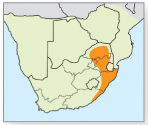

© C. VAN GINKEL
Short, creeping, indigenous aquatic sedge. Culms sharply three-angled. Inflorescence an oblong, sharp-tipped, terminal flower head with greenish spikelets. Size: 0.42–1.82m in height. Biology: Found in permanent and seasonal pools, swamps, marshes and vleis at altitudes of 2–1,400m. Flowers November–April. Used for weaving mats and making floats for fishing nets.
5 Dune-slacked sedge
Ficinia nodosa


© C. VAN GINKEL

© C. VAN GINKEL
Tufted, rhizomatous indigenous sedge. Culms cylindrical, with pointed tips. Inflorescence a roundish cluster with dark brown spikelets (5a). Size: 0.3–1.2m in height. Biology: Found in wet, saline, marshy, estuarine areas at altitudes of 0–1,500m, also in some inland areas. Flowers December–March. Planted in Australia to stabilise soil and to lower nutrient concentrations.
6 Coastal river sedge
Fuirena hirsuta

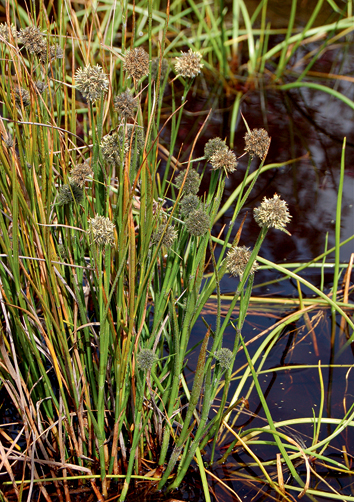
© C. GRIFFITHS

© C. VAN GINKEL
Slender, tufted, endemic aquatic sedge. Culms erect, bluntly three-angled and hairy. Inflorescence a roundish cluster, with densely hairy spikelets (6a). Size: 0.45–1.09m in height. Biology: Found on damp river margins or in wet situations along coastal regions at altitudes of 15–1,430m. Flowers October–February. Hair density of the culms shows marked variation between the southwestern and northeastern ranges.
7 Water sedge
Isolepis fluitans


© C. CILLIERS

© C. GRIFFITHS
Submerged or free-floating, cosmopolitan (but absent from Americas) aquatic sedge. Culms branching, with many internodes and leaves. Inflorescence a single terminal flower head with green spikelets. Size: 0.06–1.06m in height. Biology: Found submerged or floating in water, in seepage areas or depressions, at altitudes of 90–3,050m. Flowers January–June. RELATED SPECIES: The Waterfall sedge (7a) I. digitata forms dense clusters attached to rock surfaces in fast-flowing streams and waterfalls in the Western Cape.
8 Round-tipped sedge
Kyllinga melanosperma


© C. VAN GINKEL
Indigenous sedge widespread in tropical Africa and Asia. Culms crowded, three-sided to almost winged. Inflorescence a single, leafy, roundish terminal flower head, with yellowish-green spikelets. Size: 0.17–1m in height. Biology: Forms dense conspicuous stands along streamlet margins, always near water, at altitudes of 5–675m. Flowers October–March. Culms used to make beer sieves.
1 Clustered round sedge
Lipocarpha chinensis
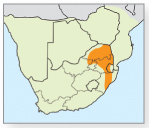
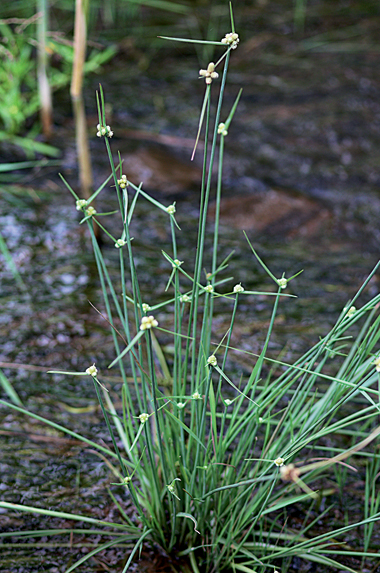
© C. VAN GINKEL
Densely tufted indigenous sedge. Culms light green, erect, cylindrical, with long leafy bracts. Inflorescence a roundish terminal flower head, with whitish-green spikelets. Size: 0.25–0.8m in height. Biology: Found on aerated stream margins or very wet mud on the fringes of drainage channels, at altitudes of 120–1,525m. Flowers April–May. Occurs in Africa, Asia and Australia and has ethnomedicinal applications: traditionally used against mental illness, while the ash is given as an analgesic for headaches.
2 Rigid sedge
Neesenbeckia punctoria


© C. VAN GINKEL
Large, rigid, tufted endemic sedge. Culms cylindrical, with basal nodes. Inflorescence a lateral flower head with light brown spikelets and a sharp spiky bract. Size: 1.5–2.4m in height. Biology: Found in seepage areas in the Western Cape at altitudes of 275–745m. Flowers March–April. The only species in the genus; endemic to the Western Cape.
3 Round-headed sedge
Oxycaryum cubense

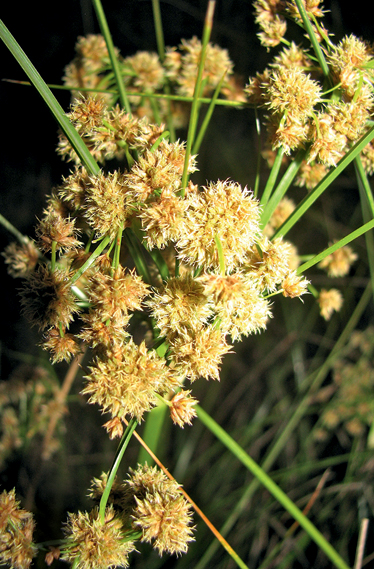
© G. VAN DER WESTHUIZEN
Uncommon, slender, untidy, floating or rooted indigenous sedge. Culms smooth, sharply three-angled, with basal nodes. Inflorescence a roughly rounded flower head with green spikelets. Size: <0.5m in height. Biology: Found growing in wet marshy grasslands, around the margins of slow-flowing streams, pools, pans and other water bodies. May also detach from the land to form free-floating mats. Altitude range 1–1,100m. Flowers year-round.
4 Hanging sedge
Pseudoschoenus inanis


© C. VAN GINKEL
Large, hanging, rhizomatous indigenous sedge with reed-like stem. Culms smooth, cylindrical, with basal nodes. Inflorescence an elongated flower head with pale brown spikelets. Size: 0.76–2.5m in height. Biology: Found growing in wet, marshy, ephemeral riverbeds and floodplains at altitudes of 395–1,525m. Flowers November–December. Culms can be used for weaving mats.
5 Golden sedge
Pycreus polystachyos


© C. VAN GINKEL
Erect, tufted and grass-like indigenous sedge. Culms sharply three-angled. Inflorescence a dense flower head with green to golden spikelets forming large golden clusters. Size: 0.6–1m in height. Biology: Found growing in wet, open, often disturbed grasslands, at altitudes of 2–1,250m. Flowers year-round. Species cosmopolitan in tropical and subtropical regions.
6 Loose river sedge
Rhynchospora brownii
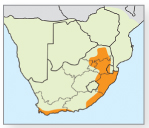

© C. VAN GINKEL
Medium-sized to large, tufted and grass-like indigenous sedge. Culms slender and three-angled, with longitudinal grooves. Inflorescence a long drooping flower head with red-brown to dark brown spikelets. Size: 0.4–1.3m in height. Biology: Found growing along margins or in shallow water of streams, rivers, vleis and pools, and in seepage areas at altitudes of 5–1,980m. Flowers December–January.
7 Soft cylindrical sedge
Schoenoplectus brachyceras


© C. VAN GINKEL
Common and widespread, slender, tufted, clump-forming indigenous sedge. Culms cylindrical and spongy. Inflorescence with short bract and pale yellow-green to dark brown spikelets. Occasionally considered to be a subspecies of Tall cylindrical sedge (see 8, below). Size: 0.05–1.6m in height. Biology: Found growing along edges of rivers and around the edges of lakes and dams, at altitudes of 850–2,000m. Flowers year-round. Used for basket weaving.
8 Tall cylindrical sedge
Schoenoplectus corymbosus
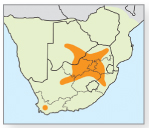

© C. VAN GINKEL
Slender, tufted, clump-forming indigenous sedge. Culms cylindrical and spongy. Inflorescence a branched flower head, borne laterally below a sharply pointed and overtopping bract, with pale yellow-green to dark brown spikelets. Size: 0.45–2.8m in height. Biology: Found growing along edges of rivers, lakes, dams and marshes, at altitudes of 300–1,770m. Flowers year-round. Used to weave mats and baskets.
1 Pipeworts
Family Eriocaulaceae

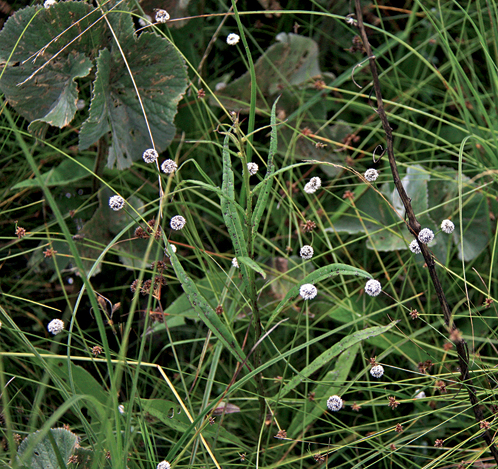
© C. VAN GINKEL
Grass-like, but distinguished from grasses and rushes by their crowded, terminal flowers borne on a leafless, spiralled flower stalk with basally crowded leaves. Flowers small and in shades of white to grey, with a black gland on inner surface and hairy white tips. Fruit a capsule. The family includes 10 genera with 1,200 described species. The River pipewort (Eriocaulon dregei) (1 and map) is a small, tufted, grass-like endemic herb. Flower stalk is surrounded by a closed sheath with crowded basal leaves. Inflorescence a terminal disc-like flower head with greyish-white flowers. Size: 0.06–0.17m in height. Biology: Found in marshes and along streams at altitudes of 15–2,000m. Flowers December–February. Inconspicuous when not flowering.
Hyacinths
Family Hyacinthaceae
Deciduous bulbous plants with lance-shaped, erect or flat leaves, leafless flower stalks and dense to loose terminal flowers. Flowers often brightly coloured with six petals arranged in two whorls of three. Fruit a capsule. Family comprised of 30 genera with about 700–900 species worldwide.
2 Giant pineapple flower
Eucomis pallidiflora


© F. KRIGE
Tall, robust, bulbous indigenous herb with broad crowded basal leaves. Inflorescence a cylindrical flower head on a long stalk, with sweet-smelling greenish-cream flowers. Size: 0.38–2.2m in height. Biology: Found in wetlands in grassland areas, often in standing water, at altitudes of 915–2,076m. Flowers January–March. Near Threatened, owing to harvesting for medicinal purposes and grazing by cattle in wetland areas. Widely marketed as a garden plant, both locally and internationally.
3 Bachmann’s lachenalia
Lachenalia bachmannii


© N. HELME
Small, emergent, bulbous, Endangered Western Cape endemic bulb, with two linear basal leaves. Inflorescence a terminal flower spike on short stalk, with bell-shaped white flowers with brown to purple spots. Size: 0.15–0.3m in height. Biology: Found on edges of seasonal pools on clay Renosterveld soils. Flowers August–September. Plants are soil stabilisers.
Tape grasses
Family Hydrocharitaceae
Creeping aquatic plants, with leaves arranged in two vertical rows or spirally arranged whorls. Flowers irregular and arranged in a forked spathe-like bract. Fruit round to linear. Family comprises 18 genera with about 616 species worldwide.
4 Water thyme
Egeria densa


© C. GRIFFITHS
Submerged and rooted, aquatic, naturalised, invasive alien herb. Stems regularly branched. Leaves blade-like and in whorls along the stem. Inflorescence has both male and female flowers that emerge on stalks above the water. Size: Water-depth dependent, found up to 3m deep. Biology: Occurs in permanent and seasonal pools. Flowers September–May. Plants can clog waterways. Used as an ornamental in aquaria.
5 Curly water thyme
Lagarosiphon major


© C. VAN GINKEL
Submerged and rooted, aquatic indigenous herb. Stems regularly branched. Leaves blade-like and in whorls along stem. Inflorescence has both male and female flowers that emerge on stalks above the water. Size: Water-depth dependent, found up to 3m deep. Biology: Occurs in permanent water bodies at altitudes of 250–850m. Flowers September–May. Native to southern Africa, but has become invasive in the United Kingdom, New Zealand and the United States.
6 Broad-leaved tape grass
Ottelia exserta


© C. CILLIERS
Floating-leaved, rooted, indigenous aquatic herb with thick leathery leaves. Inflorescence has both male and female flowers. Fruit narrow, oval and beaked. Size: 0.3–0.65m in height. Biology: Found in permanent and seasonal pools at altitudes of 40–1,100m. Flowers January–July. Widespread in East and Central Africa and used in horticulture.
Irises
Family Iridaceae
Mostly terrestrial group, but some species associated with water. Colourful flowers are arranged in two whorls of three petals that are alike in structure, shape and, often, in colour. Leaves are sword-shaped and organised edgeways to the stem. Fruit is a capsule. Family comprises >66 genera with about 2,000 species worldwide.
1 Butterfly gladiolus
Gladiolus papilio


© C. VAN GINKEL (BOTH)
Wetland, colony-forming, corm-bearing indigenous bulb. Flower stalks erect or slightly inclined. Leaves narrow and sword-like. Flowers cream to greenish, translucent pink or light purple (inset). Size: 0.3–1.2m in height. Biology: Found in marshes and damp grassland at altitudes of 5–2,350m. Flowers August–February. Used in horticulture, where showy cultivars have been developed.
2 Scarlet river lily
Hesperantha coccinea


© F. KRIGE
Colony-forming wetland plant. Flower stalks sturdy with mat-forming rhizomes. Leaves narrow, with a distinct midrib. Inflorescence a short terminal spike with scarlet flowers. Style branches rose-coloured, with pink stamens. Size: 0.2–0.45m in height. Biology: Found on stream banks at altitudes of 250–2,745m. Flowers February–April. Used in horticulture and is easily propagated from seed.
3 Aquatic romulea
Romulea multisulcata


© N. HELME
Emergent, aquatic, colony-forming, cormous endemic herb. Flower stalks branching. Leaves grooved. Inflorescence a solitary white or pale yellow flower, with a darker cup. Round fruit on a spreading stalk. Size: 0.3–0.5m in height. Biology: Found in seasonal pools on clay soils at altitudes of 50–200m. Flowers August–September. Classified as Vulnerable in IUCN Red Data Book, owing to habitat degradation caused by overgrazing, trampling and crop cultivation.
4 Star grasses
Family Hypoxidaceae


© C. GRIFFITHS
Recently recognised family of small to medium-sized herbs with grass-like leaves and stem modified into a spherical corm. The Cape star (Spiloxene aquatica) (4 and map) survives the dry season as a corm and emerges in the wet winter to produce elongate chive-like leaves. Attractive star-shaped flowers bloom in spring (August–September). Fruit a narrow cylindrical capsule. Size: About 30cm in height. Biology: Found growing in scattered groups in temporary pools and vleis in the Cape. Flowers in spring, August–September. Sold as a decorative plant for use in water features.
Rushes
Family Juncaceae
Water-associated plants, often confused with grasses or sedges. Stems lack nodes and often have inner septa (divisions). Leaves alternate, may be round, or flat, thread-like, or reduced to sheaths. Inflorescence a terminal cluster or panicle of flowers, with leaf-like bracts on top. Fruit a hard capsule. Family has six genera with about 255 species worldwide.
5 Soft rush
Juncus effusus


© C. VAN GINKEL
Soft, mat-forming, tufted indigenous rush. Stem stiff and erect, cylindrical, glossy bright green and smooth. Leaves reduced to brown scale-like structures at base. Inflorescence is a lateral cluster, with small green to light brown flowers. Size: 0.3–1.5m in height. Biology: Found in swamps, rivers, stream beds and pools at altitudes of up to 2,000m. Flowers November–January. Used to weave mats in Japan, and in Europe is soaked in grease as cheap replacement for candles.
6 Sharp-tipped rush
Juncus kraussii


© G. BRANCH
Rigid, tufted indigenous rush. Stem rigid, circular and smooth. Leaves long, narrow and cylindrical. Inflorescence (6) a dense cluster of branched heads, each bearing 3–6 reddish-brown florets and projecting laterally from just below the sharply tipped stem, which resembles those of Scirpus littoralis. Fruit narrowly ellipsoid, three-angled. Size: Up to 1m in height. Biology: Found in brackish marshy areas along the coast and at altitudes of up to 1,200m. Flowers September–January. Prevents erosion and makes a perfect fibre for weaving sleeping mats, baskets, beer strainers and other craftwork items.
7 Creeping rush
Juncus lomatophyllus


© C. GRIFFITHS
Creeping, densely leafy, short, compact indigenous rush. Stem rigid, round and smooth, with longitudinal grooves. Leaves a basal rosette. Inflorescence a terminal branched cluster, with small dark brown flowers. Fruit a capsule with a beaked tip. Size: Up to 0.8 m in height. Biology: Found in permanently wet areas at altitudes of up to 1,700m. Flowers September–January. Flower stems used to weave mats, twine and baskets. Forms an important wildlife habitat.
1 Prickly rush
Juncus punctorius


© C. VAN GINKEL

© C. VAN GINKEL
Robust, tufted indigenous rush with a rigid, round, light green flower stem. Solitary basal leaf has distinct internal transverse divisions (‘septa’). Inflorescence terminal and rounded; a branched flower cluster with small brownish flowers. Fruit a three-angled egg-shaped capsule (1a). Size: Up to 1.5m in height. Biology: Found in permanent water at altitudes of up to 2,200m. Flowers October–January.
2 Rigid rush
Juncus rigidus


© C. VAN GINKEL
Robust tufted rushes with a rigid, round, smooth flower stem. Leaves sheath tightly around stem. Inflorescence a terminal, loosely branched cluster, with small yellowish-brown flowers. Fruit a narrowly ovoid capsule. Size: 0.4–1.5m in height. Biology: Found in saline pools and marshes up to 1,300m. Flowers January–March. Culms were once used as pens to write on papyrus paper; now used to weave mats and baskets.
Duckweeds
Family Lemnaceae
Flowering, aquatic, floating or submerged plants lacking an obvious stem or fronds (leaves). The greater part of each plant is a small ‘thallus’ or ‘frond’ structure, only a few cells thick. The family contains five genera with about 37 species worldwide.
3 Fat frog-buttons, Fat duckweed
Lemna gibba


© C. VAN GINKEL
Small, floating, indigenous aquatic herb. Fronds inflated and up to 4mm thick, with solitary roots per leaf. Inflorescence solitary with small flower on frond. Size: 1–8mm in length and 0.8–6mm in width. Biology: Found floating on water surface at 0–2,000m. Cosmopolitan species found in temperate regions. This species is associated with the English myth of Jenny Green-teeth, a pond elf whose presence was indicated by this species and who supposedly lured children into ponds.
4 Common (Lesser) duckweed
Lemna minor


© C. VAN GINKEL
Small, floating, indigenous aquatic herb. Fronds flat and translucent, with solitary root beneath each leaf. Inflorescence solitary, with small flower on frond. Size: 1–8mm long and 0.6–5mm in width. Biology: Found floating on water surface at altitudes of 1–1,435m. Flowers November–December. Plants are known to occur in nutrient-enriched systems. High in protein and fat, and, as such, is an important food source for fish and birds.
5 Greater (Common) duckweed
Spirodela polyrrhiza
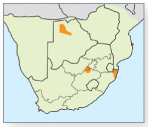

© C. CILLIERS
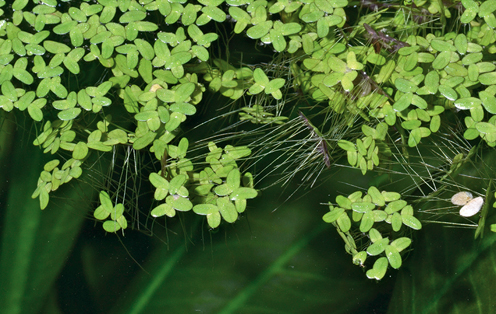
© C. GRIFFITHS

© C. GRIFFITHS
Small, colony-forming, floating, indigenous aquatic herb (5a). Fronds ovate to round, rounded or sharp at the tip, with a red fleck above the node and with a cluster of roots per frond. Inflorescence solitary, with small flower on leaf. Size: Fronds up to 1mm in height; 1.5–10mm in length and 1.5–8mm in width. Biology: Found floating on water surface in dams and pools (5b) at altitudes of 1–1,340m. Very rarely flowers or fruits. Ideal for biofuel production, nutrient removal and carbon recycling owing to their rapid rate of growth.
6 Rootless duckweed
Wolffia arrhiza


© C. GRIFFITHS
Very small, colony-forming, floating, indigenous aquatic herb. Fronds rootless, roundish to ovoid, and intensely green on upper side. This is the smallest of all flowering plants, but flowers have not been seen in South Africa. Reproduces by budding. Size: Fronds <1mm in height; 0.5–1.5mm in length and 0.4–1.2mm in width. Biology: Found floating on water surface in dams and pools at altitudes of 2–1,600m. Flowers October–December. High in protein and starch.
Submerged water grasses
Family Najadaceae
Flowering, rooted, submerged aquatic plants. Leaves simple, opposite to whorled, or alternate and toothed. Flowers solitary and found in the leaf axils. Family comprises one genus, with about 50 species worldwide.
7 Ricefield waternymph (Fine water grass)
Najas graminea


© S.RYU/CC BY SA 4.0
Slender or robust, submerged, indigenous aquatic herb. Fine spineless leaves fan out like feathers at tip of the stem. Leaf margins finely toothed. Inflorescence inconspicuous, with naked male and female flowers. Size: Stems up to 0.6m in length. Biology: Found in still or slow-flowing, fresh or brackish water, at altitudes of 496–1,300m. Flowers July–September. Global distribution. Used in the aquarium trade as an ornamental plant.
Grasses
Family Poaceae
The grasses are among the most widespread and diverse plant families on earth. Stems have nodes, and leaves have ligules between the leaf sheath and the leaf blade. The inflorescence is a terminal compound flower head that can take the form of a panicle, spike or a hand-like structure. The family includes more than 770 genera with about 9,700 species worldwide.
1 Giant reed
Arundo donax


© C. GRIFFITHS
Tall, robust, rhizomatous, exotic invading reed not confined to wet areas. Culms are woody. The sheathing leaf base is a fringe of hairs. Leaf margins finely toothed. Inflorescence an open panicle with spikelet flowers, with long hairs. Size: Stems up to 6m in height. Biology: An invader in watercourses at altitudes of 20–1,600m. Flowers February–April. A Category 1 weed, but has many uses, such as making musical instruments, lattices, mats, screens and ceilings. It can be grown as a hedge and is a source of cellulose.
2 Common reed
Phragmites australis


© C. GRIFFITHS
Tall, robust, rhizomatous exotic reed sometimes found in drier conditions. Culms unbranched and sometimes purple. The sheathing leaf base is long and tapering, with a fringe of hairs. Leaf margins finely toothed. Inflorescence a compact panicle, with silky, awned, terminal spikelet flowers. Size: 0.6–4m in height. Biology: Found along edges of rivers, shallow pools and swamps in stagnant water, at altitudes of 2–2,200m. Flowers December–June. Among the most common and widespread plants in the world; widely used for soil stabilisation, as a thatching material, for weaving mats and baskets, etc. Also provides an important wildlife habitat, especially for reed-dwelling birds.
3 Acute reed
Phragmites mauritianus
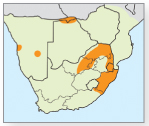

© C. VAN GINKEL
Tall, rhizomatous indigenous reed. Robust culms tilt from lower nodes. The sheathing leaf base is hairy. Leaf blades rigid and spiny. Inflorescence a brownish panicle with hairy spikelet flowers. Size: Up to 5m in height. Biology: Found at altitudes of 6–1,600m, in shallow water, on the margins of rivers, pools, swamps and dams, but never in stagnant water. Flowers January–June. Young leaves can be used as fodder, while old culms are used for thatching and weaving.
4 Hedgehog grass
Echinochloa jubata


© A. LINTSTRÖM
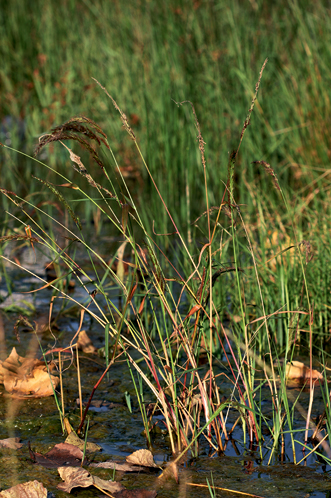
© C. VAN GINKEL
Tall, indigenous water-loving grass. Culms long and tilting (4a). Sheathing leaf base is a fringe of hairs. Leaves often floating. Inflorescence (4) a dense panicle, with narrowly elliptic spikelets with very long awns. Size: 0.5–2m in height. Biology: Found in, or floating on, open waters of permanent water bodies at altitudes of 600–1,800m. Flowers November–May. Closely related to E. stagnina, which has more loosely packed spikelets with shorter awns.
5 Red swamp grass
Hemarthria altissima


© C. VAN GINKEL
© C. GRIFFITHS
Reddish, rhizomatous indigenous grass. Culms branched above. Sheathing leaf base is a fringed membrane with a band of soft hairs. Leaves have flat blades. Inflorescence a complex cylinder with spikelets hidden in a reduced leaf-like structure (inset). Size: 0.3–1.2m in height. Biology: Found along the edges of streams, vleis and dry riverbeds at altitudes of 5–2,000m. Flowers October–July. Valuable grazing grass in wetland areas and can tolerate overgrazing.
6 Broom grass
Miscanthus junceus


© C. VAN GINKEL
Tall, tufted endemic grass. Culms erect and unbranched at the tip. Sheathing leaf base an unfringed membrane. Leaves round and slender, with hairless sheaths. Inflorescence a contracted light brown panicle with hairy spikelets and a long awn. Size: 1–2.5m in height. Biology: Found at altitudes of 75–1,800m on river banks, in floodplains and vleis and often in standing water. Flowers November–July. Used for broom making, to remove nutrients (cleansing polluted water) and to stabilise river banks.
7 Couch paspalum
Paspalum distichum
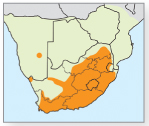

© C. VAN GINKEL

© C. VAN GINKEL
Water-loving, mat-forming invader grass, possibly originating in the Americas but now widely introduced. Culms creeping. Sheathing leaf base is a membrane. Leaves linear. Inflorescence comprises two racemes with spikelets arranged in two rows. Size: 0.1–0.6m in height. Biology: Found at altitudes of 1–1,815m in or around salt- or freshwater bodies, on river banks, in vleis and along the edges of pans. Flowers November–May. It is used as a traditional medicine and can be fed to sheep during winter months. RELATED SPECIES: Giant paspalum (P. urvillei) (7a) is a tall, densely tufted, erect, invader grass found along the entire eastern side of South Africa. Sheathing leaf base is hairy and membranous.
1 Seaside quick grass
Stenotaphrum secundatum


© C. VAN GINKEL (BOTH)
Hardy, mat-forming, indigenous grass. Culms have numerous nodes. Sheathing leaf base a fringed membrane. Leaves hairless and keeled, with strongly flattened sheaths. Inflorescence a spike-like raceme, with spikelets in hollow cavities on both sides (inset). Size: 4–6cm in height. Biology: A coastal pioneer along beaches and marshes in both freshwater and saline conditions, at altitudes of 1–900m. Flowers October–May. Used for food in famine-stricken areas and useful against soil erosion and for stabilising river banks.
2 Gingers
Family Zingibaraceae
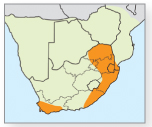

© C. GRIFFITHS
Family of 52 genera and over 1,300 species of perennial herbs, with creeping horizontal rhizomes. Many are important as ornamentals, spices or medicines. Wild ginger (Hedychium gardnerianum) (2 and map) has long bright green leaves spread laterally from tall stems, which emerge from creeping stolons. Inflorescence a bright yellow spike of fragrant flowers. Size: Up to 2m in height. Biology: Native to Asia, but widely introduced as an ornamental; a pest in New Zealand, Hawaii and South Africa. Flowers in summer. Recognised by IUCN as one of the ‘100 Worst Invasive Alien Species’. Forms dense stands along streams, blocking light and smothering local species. Sticky seeds readily spread by birds and mammals.
3 Bloodworts
Family Haemodoraceae


© C. GRIFFITHS
Mainly southern family, comprising 116 species of perennial herbaceous plants with leathery leaves; often produce bright red pigments. Bloodroot (Wachendorphia thyrisiflora) (3 and map) emerges from distinctive red rhizome containing bright red sap, from which name is derived. Leaves long, hairless, broadly sword-shaped, with pleated blades. Flowers bright golden yellow, borne in cylindrical groups on tall sturdy stalk. Size: Leaves up to 1m in length and flower stalk 2m. Biology: In permanent marshes, seepages and streams. Flowers September–December. Easily propagated from rhizomes; a popular garden plant for marshy sites.
Pickerel weeds
Family Pontederiaceae
Primarily aquatic, rooted or free-floating plants found in tropical and subtropical regions. Stems spongy with large air spaces within, and with basal leaves. Inflorescences solitary or aggregated in compound flower heads, which can be panicles, spikes or racemes, with a pair of leaf-like or sheathing bracts. Nine genera, with about 33 species worldwide.
4 Heart-shaped pickerel
Heteranthera callifolia


© A. LINTSTRÖM
Fleshy, creeping, indigenous aquatic plant. Leaves heart-shaped, with long swollen stalks. Inflorescence a terminal spike with blue, white, mauve or violet flowers with three stamens. Size: 0.2–0.4m in height. Biology: Found in swampy areas, vleis, pans or rock pools at altitudes of 900–1,250m. Flowers in February. Used in traditional medicine for dementia-related memory loss.
5 Pickerel weed
Pontederia cordata


© C. VAN GINKEL (BOTH)
Erect, fleshy, rooted, naturalised exotic aquatic plant. Leaves heart-shaped, with smooth margins and outwardly curved veins on the blades. Inflorescence a terminal spike subtended by a leaf-like spathe with purplish flowers bearing six stamens (inset). Size: Up to 1.2m in height. Biology: Found in shallow water, sometimes in brackish water, at altitudes of 20–1,620m. Flowers October–April. A Category 3 declared weed.
6 Water hyacinth
Eichhornia crassipes


© C. GRIFFITHS
Erect, fleshy, free-floating aquatic plant. An exotic invader. Stems fleshy; floating leaves broadly ovate with pronounced swollen bases. Inflorescence a terminal spike with mauve-blue flowers bearing six stamens. Size: 0.2–0.5m in height. Biology: Found in lakes, pans and rivers at altitudes of 1–1,650m. Flowers November–May. The most damaging aquatic weed in South Africa and a major pest in warmer climates globally, clogging waterways, disrupting fishing, reducing oxygen levels and impacting on biodiversity. A Category 1 declared weed imported from South America. Integrated control includes both biological and chemical methods.
Pondweeds
Family Potamogetonaceae
Erect, submerged or creeping aquatic plants. Stems spongy, with large air spaces within, and with basal leaves. Inflorescences solitary or aggregated in compound emergent spikes; flowers lack petals and each bear four sepals, four stamens and four carpals. Family consists of six genera with about 120 species worldwide.
1 Wavy-leaved pondweed
Potamogeton crispus


© C. VAN GINKEL
Submerged, indigenous aquatic plants with flattened stems that are wavy, grooved, angular, simple or branched and often reddish. Leaves are submerged, elongate and parallel-sided with toothed margins. Inflorescence a terminal emerging spike, with inconspicuous brownish flowers on swollen flower stalks. Size: Water-depth dependent; stems up to 3m in height. Biology: In permanent water bodies at altitudes of up to 1,200m. Flowers October–December. Leaves and roots are edible.
2 Broad-leaved pondweed
Potamogeton nodosus


© C. VAN GINKEL

© C. VAN GINKEL
Creeping, indigenous aquatic plant with unbranched, orange-brown, cylindrical stems. Ovate leaves with long stalks may be aerial, floating or submerged. Inflorescence a terminal emerging spike with inconspicuous brownish flowers on swollen flowers stalks (2a). Size: Water-depth dependent, but up to 3m. Biology: In permanent water bodies at a variety of altitudes. Flowers October–April. Provides food for animals and birds and habitat for many smaller species.
3 Fennel-leaved pondweed
Stockenia pectinatus


© C. VAN GINKEL
Colony-forming, submerged aquatic perennial. Leaves dark green, very thin, submerged, with toothed margins. Inflorescence a spike with about five whorls of brownish flowers. Size: Water-depth dependent, but up to 3m. Biology: Found in fresh or brackish water at altitudes of 1–1,740m. Flowers October–December. Important source of food and nesting material for waterbirds. Provides habitat and shelter for invertebrates and fish.
4 Submerged pondweed
Potamogeton schweinfurthii


© C. VAN GINKEL
Colony-forming, submerged indigenous aquatic perennial with round stems that are somewhat woody and emerge from terminal bulb-like tubers. Leaves yellowish green to brownish, translucent, submerged and narrowly sword-like. Inflorescence consists of multiple emerging spikes with inconspicuous greenish flowers. Size: Water-depth dependent, but up to 3m. Biology: In clear, still or flowing water at altitudes of up to 1,560m. Flowers July–December. Provides food and shelter for fish, birds and insects.
5 Palmiet
Family Prioniaceae


© C. GRIFFITHS
Rush-like with serrated leaves; the net-like skeletal remains of old leaf sheaths are a distinctive characteristic. Family comprises one genus and a single endemic species. Palmiet (Prionium serratum) (5 and map) is a robust, clump-forming and tufted endemic with woody stems covered densely with black netting. Leaves long, narrow and tapering, with serrated margins. Inflorescences many-flowered panicles with brown flowers. Size: 0.33–2.5m in height. Biology: Found in dense stands along permanent rivers, lakes and pools, at altitudes of 50–1,200m, particularly near the coast. Flowers September–February. Young flower shoots are eaten as a vegetable. Leaves are used for basketry, making hats and mats; the plants are used to stabilise river banks.
6 Restios
Family Restionaceae


© C. GRIFFITHS
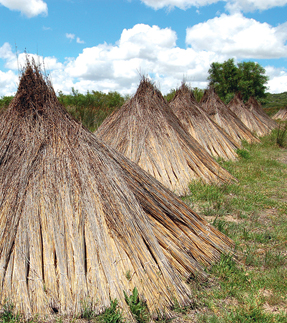
© C. GRIFFITHS
Rush-like plants characteristic of the fynbos biome. Most characteristic feature are spathes that form part of the inflorescence. Male and female are different, and the small brownish flowers are borne on loosely branched inflorescences. Family comprises 58 genera with about 520 species, of which 320 are endemic to South Africa. The Broom restio (Calopsis paniculata) (6 and map) is a tall, clumped and tufted endemic. Stems sparsely branched and bamboo-like. Leaf sheaths persistent. Inflorescences much-branched panicles in both male and female plants. Size: 1–2.5m in height. Biology: Found in and along rivers at 18–1,525m. Flowers March–June. Used to make brooms in the Eastern Cape, also in horticulture and for flower arrangements. The Thatching reed (Elegia tectorum) (6a) (Clanwilliam to Port Elizabeth) grows in dense reed-like tufts in damp areas. Small flowers borne in loose branched groups, those of the female protected by golden-brown bracts. Grows 1.5–2.25m tall and found in marshes and seeps in deep sand. Long used as a thatching material and for the manufacture of brooms and baskets.
Bulrushes
Family Typhaceae
Robust creeping plants. Their most characteristic features are the long two-ranked lanceolate leaves and solitary spike-like inflorescences bearing inconspicuously small flowers. Family comprises two genera with about 12 species.
1 Short bulrush
Typha capensis
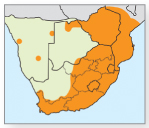

© C. GRIFFITHS
Familiar, clumped, tufted and indigenous plant, with simple erect stems. Leaves 0.4–1.5m in height. Inflorescences thick solitary spikes with little to no space between upper male and lower female flowers. Size: Up to 2m in height. Biology: Found along watercourses and in marshy areas at altitudes of 0–1,800m. Flowers March–June. Ecologically important as nesting material and habitat for birds and other water-associated animals. Used in traditional medicine and in craft work and house building.
2 Tall bulrush
Typha domingensis


© C. VAN GINKEL
Tall, clumped, tufted and cosmopolitan plant with simple erect stems. Leaves 0.3–4m in height. Inflorescences long, thin, solitary spikes. Upper male and lower female flowers separated by a few centimetres. Size: Up to 5m in height. Biology: Found along watercourses and in marshy areas at altitudes of 900–1,900m. Flowers March–June. Roots are rich in starch and can be eaten like potato; when ground, they can be used as thickener in soups and as flour for making breads, biscuits and cakes.
Yellow-eyed grasses
Family Xiridaceae
Plants small; rush-like stem reduced, corm-like; leaves in two rows, stems often twisted. Inflorescence a simple terminal head on a naked stem. Short-lived bright yellow flowers. Family comprises five genera with about 300 species.
3 Cape yellow-eye
Xyris capensis


© C. CILLIERS

© C. CILLIERS
Small tufted, indigenous herb; stems round, spirally twisted and sometimes with longitudinal ridges. Leaves basal, but do not persist; flowers yellow (3a). Size: 0.07–0.91m in height. Biology: Found in very wet areas, at altitudes of 0–1,350m. Flowers October–May. A widespread pioneer species in South Africa. Used to make beer strainers. In Java culms are used to make Hindu figures.
4 Membranous yellow-eye
Xyris gerrardii


© C. CILLIERS

© C. VAN GINKEL
Tufted, rush-like indigenous herb; stems thread-like and twisted. Leaves are basal. Flower bracts with dry membranous margins (4a). Size: 0.16–0.55m in height. Biology: Found on stream banks and seepage areas at altitudes of 1,600–2,134m. Flowers November–January. Habitat threatened, but can form large stands in protected areas.
Net-veined plants
Dicotyledons
Flowering plants with two embryonic seed leaves or cotyledons that usually appear at germination. Leaves net-veined; flowers consist of four or five parts, or multiples thereof. The group includes around 200,000 species.
Carrot plants
Family Apiaceae
Aromatic hollow-stemmed herbs. Leaves alternate; flowers vary in colour. Family comprises 434 genera with about 3,700 species.
5 Toothache root
Berula erecta


© C. VAN GINKEL

© C. VAN GINKEL
Erect, emergent or floating indigenous herb. Stems hollow with longitudinal grooves. Leaves fern-like. Flowers whitish on flattish flower heads (5a). Size: 0.2–1.8m in height. Biology: Found in flowing or stagnant water at altitudes of 1–2,105m. Flowers October–April. Used as traditional medicine for toothache and as a treatment for rheumatism, rashes and athlete’s foot.
6 Water parsnip
Berula repanda


© C. VAN GINKEL
Erect, emergent or floating indigenous herb. Stems hollow with longitudinal grooves. Leaves fern-like. Flowers yellowish- to greenish-white, in clusters forming flat flower heads. Size: Up to 1.5m in height. Biology: Found in or along rivers at altitudes of 550–2,150m. Flowers October–April. Can be used as a soil stabiliser if planted in smaller streamlets.
1 Milkweeds
Family Apocynaceae
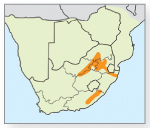
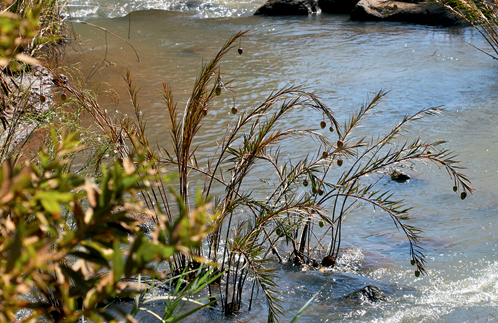
© C. VAN GINKEL
Trees, shrubs and herbs that contain milky latex that can be poisonous. Family comprises 424 genera with about 1,500 species. The River milkweed (Gomphocarpus rivularis) (1 and map) is a many-branched, emergent, indigenous plant with pinkish-red stems and leaves whorled at nodes. Inflorescences in axillary clusters. Flowers cream with reflexed lobes. Size: 0.5–1.8m in height. Biology: Found in riverbeds at altitudes of 750–1,500m. Flowers December–January. Habitat threatened by river regulation and competition from alien invasive plants.
Ivies
Family Araliaceae
Creeping and rooting at most nodes. Leaves solitary or in clusters. Family of 60 genera with 1,350 species.
2 Kidney-shaped pennywort
Centella asiatica
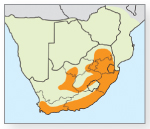
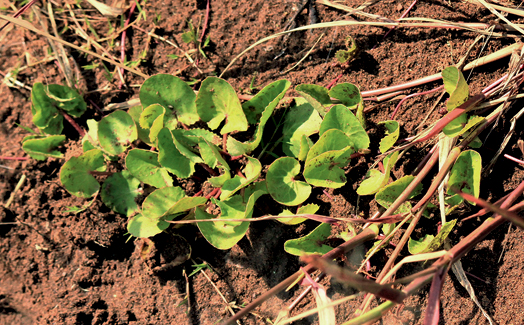
© C. VAN GINKEL
Many-branched, emergent, creeping indigenous herb; leaves kidney-shaped to roundish and occasionally thinly hairy. Inflorescence an umbel with 2–3 dark crimson to greenish-white flowers. Size: Up to 0.2m in height. Biology: Found in marshy areas at altitudes of 5–2,000m. Flowers September–May. Used as a leafy green in Sri Lankan cuisine, a salad in Indonesia and in traditional medicine for numerous ailments.
3 Round pennywort
Hydrocotyle bonariensis
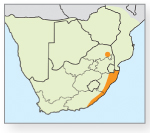

© C. GRIFFITHS
Creeping, mat-forming and emergent; leaves roundish with stalks attached to lower surfaces, on confluence of leaf veins. Inflorescence a terminal cluster on long stems, with small yellowish flowers. Size: Up to 0.3m in height. Biology: Found in wet places, often near the sea, at altitudes of 0–50m. Flowers year-round. Used as food and has medicinal compounds that help blood vessels to relax, thus assisting patients with high blood pressure.
Daisies
Family Asteraceae
Ecologically and economically important group of mostly herbaceous plants, distinguished by their composite flowers. Very diverse family with 1,620 genera and 23,000 species.
4 Brass buttons
Cotula coronopifolia
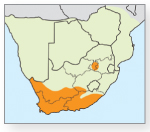

© C. GRIFFITHS
Sprawling and indigenous aquatic plant; stems creeping and erect. Leaves alternate and fleshy, with sheathing bases. Flowers bright yellow and borne on a thick disc-like inflorescence. Size: 0.03–0.5m in height. Biology: In fresh and brackish waters at altitudes of up to 2,000m. Flowers January–June. Used to produce a brassy gold dye and as a ground cover in horticulture.
5 Small purple daisy
Denekia capensis


© C. VAN GINKEL

© C. VAN GINKEL
Small, sturdy, aromatic and indigenous aquatic plant, stems simple and sticky. Leaves sessile, often with reddish margin. Inflorescence (5a) a small terminal flower head bearing purple flowers. Size: 0.07–0.7m in height. Biology: Found in damp places in shallow water and in marshes, or along marshy stream banks at altitudes of 30–2,400m. Flowers year-round. Used for making hats.
6 Vlei pom-pom
Doellia caffra

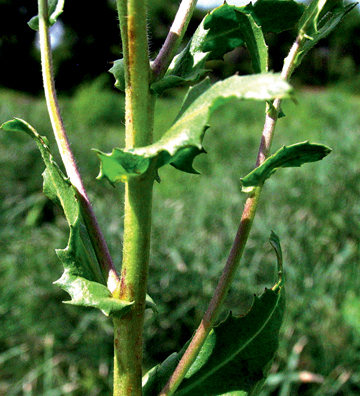
© A. LINTSTRÖM

© A. LINTSTRÖM
Erect, emergent, indigenous aquatic plant. Stems often reddish with sessile, and ear-lobed leaves with teethed margins. Inflorescence (6a) a terminal purplish flower on a long flower stem. Size: <1m in height. Biology: In marshy or moist sandy areas at altitudes of 10–2,000m. Flowers July–June.
7 Mustard flowers
Family Brassicaceae


© C. GRIFFITHS
Herbaceous plants with alternating leaves and four-petalled flowers. Family comprises about 330 genera with 3,700 species. Watercress (Nasturtium officinale) (7 and map) is a spreading, emergent, invasive aquatic species, with much-branched, creeping, erect stems. The lowest leaves are almost round. Small white flowers borne in clusters. Size: 0.15–0.60m in height. Biology: In nutrient-enriched water and wet ground along streams at altitudes from 50–2,300m. Plants flower September–March. Originated in Europe and cultivated for food. Category 2 declared weed.
1 Butterfly bushes
Family Buddlejaceae


© C. CILLIERS
Herbaceous shrubs with opposite lanceolate leaves. Inflorescence branched, with stalked flowers or a flat-topped or convex cluster. Family comprises nine genera with 150 species. River stars (Gomphostigma virgatum) (1 and map) is a spreading, emergent, indigenous aquatic shrub, with slender silver-grey stems. Leaves may be hairless or covered in silvery hairs. Inflorescence a slender terminal head, with white flowers and purple anthers. Size: 0.3–2m in height. Biology: Found in rocky stream beds at altitudes of 110–2,410m. Flowers November–September. Used in horticulture and easily propagated from cuttings.
2 Hornworts
Family Ceratophyllaceae


© C. GRIFFITHS

© C. VAN GINKEL
Rootless, submerged aquatic plants with long branched stems giving rise to periodic whorls of slender branched leaves. Flowers small, attached at junction of leaf and stem. Fruit a small spiny nut. Family comprises a single genus and about 30 species. Common hornwort (Ceratophyllum demersum var. demersum) (2 and map) is a spreading, emergent, indigenous aquatic species; stems slender and branching. Leaves (2a) needle-like whorls, twice forked, with small spines on margins. Single inflorescences located in leaf axils, with submerged, inconspicuous, greenish-white or orange flowers. Size: Up to 3m in length. Biology: In slow-moving water in coastal and inland rivers and streams, at altitudes of 1–1,700m. Flowers irregularly in summer. A popular floating plant for use in aquaria.
Gentians
Family Gentianaceae
Trees, shrubs and herbs with a wide range of colours and floral patterns. Flowers have fused sepals and petals. Family comprises 87 genera and 1,600 species.
3 Marsh chironia
Chironia palustris


© C. VAN GINKEL
Erect, straggling, colony-forming indigenous herb, with very slender stems. Leaves form basal rosette. Inflorescence loose, with pink flowers and twisted anthers. Size: 0.3–0.7m in height. Biology: Damp marshy grassland in riparian zones, at altitudes of 15–1,890m. Flowers November–June. Used as a traditional medicine in treating diarrhoea and colic in children.
4 Dwarf chironia
Chironia purpurascens subsp. humulis


© C. VAN GINKEL
Slender, erect, straggling indigenous herbs, with very slender stems. Leaves blue-green and basal. Inflorescence branched, with magenta-pink flowers and strongly twisted anthers. Size: 0.2–0.8m in height. Biology: In damp marshy areas at altitudes of 45–2,100m. Flowers October–June. Used in traditional medicine to prepare a tea for treating stomach disorders.
5 Yellow flowered sebaea
Sebaea leiostyla


© C. CILLIERS

© C. VAN GINKEL
Slender, erect, indigenous herb; stems four-angled with opposite, light green basal leaves. Inflorescences bright yellow terminal clusters (5a). Size: 0.2–0.8m in height. Biology: In wet marshy grassland, at altitudes of 61–2,775m. Flowers year-round. Used as an ornamental plant and traditional snakebite remedy.
6 Geraniums
Family Geraniaceae


© C. CILLIERS
Herbaceous flowering plants with lobed or shield-shaped leaves. Flowers regular or symmetrical. Family comprises 10 genera and 800 species. Crane’s bill (Geranium caffrum) (6 and map) is an endemic herb; stems slender with woody base. Leaves digitally 3–5-lobed and finely hairy. Inflorescence comprising 1–2 dainty white or light pink flowers. Size: 0.4–0.6m in height. Biology: In damp marshy areas at altitudes of 305–680m. Flowers September–January. Used in traditional medicine for cleaning wounds.
7 Rhubarbs
Family Gunneraceae


© C. VAN GINKEL
Large, herbaceous, flowering plants. Family comprises one genus and 69 species. Wild rhubarb (Gunnera perpensa) (7 and map) is a robust, colony-forming, emergent, indigenous aquatic plant, with stems covered in short hairs. Leaves large and tufted, margins lobed with small rough-edged teeth. Inflorescences are long spikes with pinkish to reddish flowers. Size: 0.3–1.5m in height. Biology: In damp marshy grassland, at altitudes of 60–2,775m. Flowers September–May. Used in traditional medicine to help expel the placenta after birth and to relieve menstrual pains.
1 Watermilfoils
Family Haloragaceae


© C. GRIFFITHS

© C. GRIFFITHS
Large, herbaceous, flowering family, with seven genera and 76 species. Parrot’s feather (Myriophyllum aquaticum) (1 and map) is a floating, emergent, aquatic invasive, with whorled feathery leaves. Solitary inflorescences borne in leaf axils. Size: Up to 1.2m in height. Biology: In streams and pools at altitudes of 5–1,750m. Introduced in 1918. A declared weed, impeding water flow and hindering fishing and recreational use of water bodies. A defoliating beetle (Lysathia) was introduced successfully in 1994 for biological control. Spiked watermilfoil (M. spicatum) (1a) is completely submerged except for flower spike. Introduced from Europe; now widespread. A serious pest; obstructs water flow and recreational activities.
2 Bladderworts
Family Lentibulariaceae
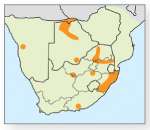

© C. GRIFFITHS

© C. GRIFFITHS
Carnivorous flowering plants. Family comprises five genera and 220 species. The Yellow bladderwort (Utricularia gibba) (2 and map) is an aquatic or subaquatic indigenous herb, with very slender stems and sparsely dissected leaves. Inflorescence an emergent stalk with yellow flowers. Size: 0.02–0.12m in height. Biology: Found in shallow water around ditches, streams and lakes, at altitudes of 1–1,525m. Flowers October–June. Bladders on the stems (2a) act as floats or traps for smaller organisms and retain water for dry periods. Bladders have appendages at entrance, which trigger when prey swims past, capturing the victim.
Buckbeans
Family Menyanthaceae
Aquatic flowering herbs with floating leaves and clusters of flowers on expanded floral axes. Family comprises six genera and 60–70 species.
3 Floating heart
Nymphoides indica subsp. occidentalis


© C. VAN GINKEL

© C. VAN GINKEL
Rooted, emergent, indigenous aquatic plants, with branched stems and broadly ovate, thick, leathery leaves. Inflorescence (3a) umbrella-like with yellow-throated fringed white petals. Size: Up to 0.25m in height. Biology: In wet areas or open water at altitudes of 155–1,650m. Flowers December–February. Used in horticulture as a soil stabiliser; young leaves and stems are edible.
4 Yellow floating heart
Nymphoides thunbergiana


Rooted, emergent, indigenous aquatic plants, with branched stems and broadly ovate, thick, leathery leaves. Inflorescence umbrella-like, with yellow flowers and middle vein also fringed with hairs (inset). Size: Up to 0.5m in height. Biology: In fresh and brackish waters in sheltered areas of lakes, pans and slow-flowing waters at altitudes of 151–600m. Flowers in November. Used in garden water features and as soil stabiliser.
Water lilies
Family Nymphaeaceae
Aquatic, large-flowered, floating-leaved herbs. Family comprises eight genera and about 70 accepted species.
5 White water lily
Nymphaea lotus

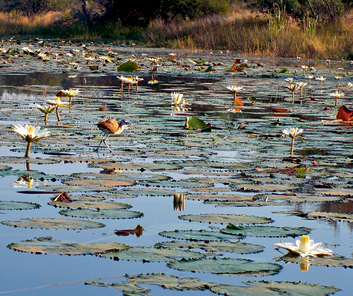
© F. KRIGE
Rooted, floating-leaved, indigenous aquatic plant with spongy stems; leaves ovate to round, dark green above and greenish below. Inflorescence solitary, held above the water, with fragrant white or slightly yellowish flowers. Size: Up to 3m. Biology: Found in rivers, lakes and pools at altitudes of 10–1,650m. Flowers year-round. Used in traditional medicine. Plants provide habitat for fish, insects, birds, frogs, etc.
6 Blue water lily
Nymphaea nouchali var. caerulea


© C. GRIFFITHS
Rooted, indigenous aquatic plant with spongy stems and floating rounded leaves that lack raised veins. Inflorescence solitary with sweet-smelling blue to lilac flowers. Size: Water-depth dependent, at depths of up to 3m. Biology: In rivers, lakes and pools at altitudes of 10–650m. Flowers August–March. Used in horticulture and provides natural habitat for fish, insects, and birds. Several similar species in region, with slight differences in leaf morphology, size, shape and flower colour.
7 Water chestnuts
Family Trapaceae


© K. ZIARNEK/CC BY SA 3.0
Small family consisting of the single genus Trapa, with about 20 species. The Water chestnut (T. natans) (7 and map) is anchored to fine mud by very fine roots; long submerged stems extend to surface where they bear rosette of triangular floating leaves with serrated margins. Inflated petiole provides buoyancy. Flowers white and four-petalled. Fruit a nut with four barbed spines. Size: Leaves about 5cm, stem can be several metres. Biology: Form floating masses, especially in nutrient-rich waters. Fruits can be eaten raw or cooked; widely cultivated in Asia.
1 Willow herbs
Family Onagraceae


© C. GRIFFITHS
Herbs, shrubs and trees with brightly coloured flowers. Family includes 17 genera and about 650 species. The African willow herb (Ludwigia adscendens subsp. diffusa) (1 and map) is a smooth or hairy, rooted, floating, indigenous aquatic herb with spongy, smooth or hairy stems; leaves shiny dark green and narrowly lanceolate. Solitary inflorescences borne in axils, with yellow flowers and an elongated capsule as fruit. Size: 0.5–1m in height. Biology: Found in wet swampy places at altitudes of 0–1,100m. Flowers August–March. Used as a poultice for ulcers and other skin ailments and to alleviate swelling.
2 Plantains
Family Plantaginaceae


© C. VAN GINKEL
Herbs and shrubs, including a number of true aquatics with irregular flowers comprising 4–8 petals. Family consists of 110 genera and about 1,115 accepted species. Broad-leaved plantain (Plantago major) (2 and map) is a thinly hairy tufted herb, with 3–7 ribbed ovate leaves with woolly axils. Inflorescence an elongated solitary spike with whitish flowers. Size: 0.1–0.45m in height. Biology: An alien species from Eurasia occurring in moist sunny areas at altitudes of 10–1,705m. Flowers September–February. Edible leaves used in traditional medicine to treat mouth and ear ailments, as well as to ease childbirth and diarrhoea.
Knotweeds
Family Polygonaceae
Herbs and shrubs, including a number of aquatics, with irregular 4–8-petalled flowers. Family comprises 110 genera and about 1,115 accepted species.
3 Floating knotweed
Persicaria amphibia


© C. VAN GINKEL
Floating-leaved, naturalised aquatic herb, with stems swollen at nodes and leaves floating and broadly elliptic. Inflorescence a dense spike with red to deep pink flowers; fruit is a nut, shaped like a biconvex lens. Size: Up to 0.6m in height. Biology: In ponds, ditches, dams and waterways at altitudes of 150–1,860m. Flowers September–May. Used as fodder and in traditional medicine in North America, as well as in horticulture.
4 Pale persicaria
Persicaria lapathifolia


© C. GRIFFITHS
Decumbent (lying flat) or erect aquatic herbs; stems have loosely tubular membranous node sheaths with approximately 0.2mm-long hairs. Leaves blotched and narrowly lanceolate. Inflorescence a slender drooping spike with pink to greenish-white flowers. Size: 0.1–3m in height. Biology: Found in standing waters at altitudes of 0–2,380m. Flowers September–May. Whole plant is antiseptic and caustic.
5 Buttercups
Family Ranunculaceae


© C. VAN GINKEL
Large family comprising 60 genera and about 1,700 accepted herb species with 4–5-petalled flowers. Spotted knotweed (Ranunculus meyeri) (5 and map) is a delicate, mat-forming, endemic, aquatic, emergent indigenous herb; stems are runners; leaves small and heart-shaped. Has solitary inflorescence with yellow flowers and clustered, dry, single-seeded fruits. Size: 0.07–0.25m in height. Biology: In marshy pools or shallow streams at altitudes of 350–3,500m. Flowers September–February. Soil stabilisers in wetland areas.
Figworts
Family Scrophulariaceae
Annual or perennial herbs (with one genus of shrubs) with 4–5-petalled zygomorphic flowers. Family cosmopolitan, mostly temperate and comprises 87 genera with about 985 accepted species.
6 Mudwort
Limosella grandiflora


© A. LINSTRÖM
Small, erect indigenous herb; stems are runners. Leaves floating or erect. Inflorescence solitary, with white or lilac flowers and ovoid-ellipsoid fruit capsule. Size: 0.01–0.3m in height. Biology: Found at edges of pools at altitudes of 3–1,950m. Flowers August–November. Traditionally the stem is cut into pieces to make necklaces for Xhosa mothers who are nursing.
7 Long-stemmed mudwort
Limosella longiflora


© C. VAN GINKEL
Small, dense, colony-forming, tufted, submerged or emergent, erect herbs; stems are runners. Leaves needle-shaped, erect to spreading. Inflorescences solitary on long pedicels, with very pale blue to lilac flowers. Size: 1–10cm in height. Biology: On muddy or sandy edges of pans and shallow water, at altitudes of 1,160–3,230m. Flowers September–November.